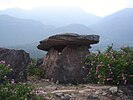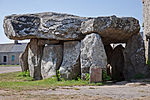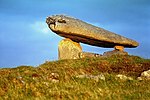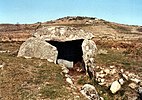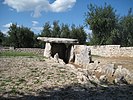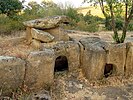Dolmen

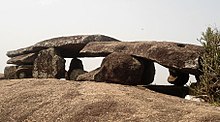
A dolmen (/ˈdɒlmɛn/) or portal tomb is a type of single-chamber megalithic tomb, usually consisting of two or more upright megaliths supporting a large flat horizontal capstone or "table". Most date from the Late Neolithic period (4000–3000 BCE) and were sometimes covered with earth or smaller stones to form a tumulus (burial mound). Small pad-stones may be wedged between the cap and supporting stones to achieve a level appearance.[1] In many instances, the covering has eroded away, leaving only the stone "skeleton".
Etymology
Celtic
The word dolmen entered archaeology when
In
Germanic
Dolmens are known by a variety of names in other languages, including Galician and Portuguese: anta, Bulgarian: Долмени, romanized: Dolmeni, German: Hünengrab/Hünenbett, Afrikaans and Dutch: hunebed, Basque: trikuharri, Abkhaz: Adamra, Adyghe: Ispun
Danish and Norwegian: dysse, Swedish: dös, Korean: 고인돌, romanized: goindol (go-in = 'propped' + dol = 'stone'), and Hebrew: גַלעֵד. Granja is used in Portugal, Galicia, and some parts of Spain.[citation needed] The rarer forms anta and ganda also appear. In Catalan-speaking areas, they are known simply as dolmen, but also by a variety of folk names, including cova ('cave'),[7] caixa ('crate' or 'coffin'),[8] taula ('table'),[9] arca ('chest'),[7] cabana ('hut'), barraca ('hut'), llosa ('slab'), llosa de jaça ('pallet slab'),[10] roca ('rock') or pedra ('stone'), usually combined with a second part such as de l'alarb ('of the Arab'),[8] del/de moro/s ('of the Moor/s'),[8][11] del lladre ('of the thief'), del dimoni ('of the devil'), d'en Rotllà/Rotllan/Rotlan/Roldan ('of Roland'),.[9][8] In the Basque Country, they are attributed to the jentilak, a race of giants.
The
Western Europe
Origin and purpose
It remains unclear when, why and by whom the earliest dolmens were made.[dubious ] The oldest known are found in Western Europe, dating from c. 7,000 years ago. Archaeologists still do not know who erected these dolmens, which makes it difficult to know why they did it. They are generally all regarded as tombs or burial chambers, despite the absence of clear evidence for this. Human remains, sometimes accompanied by artefacts, have been found in or close to the dolmens which could be scientifically dated using radiocarbon dating. However, it has been impossible to prove that these remains date from the time when the stones were originally set in place.[12]
Middle East
Dolmens can be found in the Levant, some along the Jordan Rift Valley (Upper Galilee in Israel, the Golan Heights,[13] Jordan, Lebanon, Syria, and southeast Turkey.[14][15]
Dolmens in the Levant belong to a different, unrelated tradition to that of Europe, although they are often treated "as part of a trans-regional phenomenon that spanned the
Korea
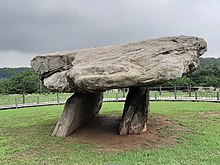
Dolmens were built in Korea from the Bronze Age to the early Iron Age, with about 40,000 to be found throughout the peninsula.[16] In 2000,[16] the dolmen groups of Jukrim-ri and Dosan-ri in Gochang, Hyosan-ri and Daesin-ri in Hwasun, and Bujeong-ri, Samgeori and Osang-ri in Ganghwa gained World Cultural Heritage status.[17] (See Gochang, Hwasun and Ganghwa Dolmen Sites.)
They are mainly distributed along the West Sea coastal area and on large rivers from the Liaoning region of China (the Liaodong Peninsula) to Jeollanam-do. In North Korea, they are concentrated around the Taedong and Jaeryeong Rivers. In South Korea, they are found in dense concentrations in river basins, such as the Han and Nakdong Rivers, and in the west coast area (Boryeong in South Chungcheong Province, Buan in North Jeolla Province, and Jeollanam-do.[16] They are mainly found on sedimentary plains, where they are grouped in rows parallel to the direction of the river or stream.[16] Those found in hilly areas are grouped in the direction of the hill.[16]
Types
- Great dolmen – Type of dolmen in Nordic megalith architecture
- Inuksuk – Inuit built stone landmark or cairn
- Polygonal dolmen – Type of dolmen with five to nine supporting stones
- Rectangular dolmen – Rectangular, enlarged or extended dolmen
- Simple dolmen – Early form of dolmen or megalithic tomb
-
Trethevy Quoit – one of the best-preserved in Cornwall, UK dated to around 3500–2500 BCE
-
Chûn Quoit in Cornwall, UK, about 2400 BCE
-
Lanyon Quoit in Cornwall, UK, 3500–2500 BCE
-
A dolmen erected by Neolithic people inKerala, India.
-
Dolmens ofMarayoor, India.
-
A southern-style dolmen at Ganghwa Island, South Korea
-
The biggest dolmen nearHwasun, South Korea
-
Crucuno dolmen in Plouharnel, Brittany, France
-
Kilclooney More dolmen near Ardara, County Donegal, Ireland
-
Lancken-Granitz dolmen, Germany
-
T-shaped Hunebed D27 in Borger-Odoorn, Netherlands
-
Dólmen da Aboboreira,Baião, Portugal
-
Dolmen of Avola, Sicily
-
Dolmen of Fasano, Apulia
-
Tinkinswood, Vale of Glamorgan, Wales, around 3000 BCE
-
Dolmen ofOleiros, Galicia
-
Dolmen Sa Coveccada, Mores, Sardinia
See also
- Irish megalithic tombs
- List of dolmens
- List of megalithic sites
- Megalithic art
- Neolithic Europe
- Nordic megalith architecture
References
- ^ Murphy (1997), p. 43.
- ISBN 978-9088900341.
- ^ Corret de la Tour d'Auvergne, Origines gauloises. Celles des plus anciens peuples de l'Europe puisées dans leur vraie source ou recherche sur la langue, l'origine et les antiquités des Celto-bretons de l'Armorique, pour servir à l'histoire ancienne et moderne de ce peuple et à celle des Français, p. PR1, at Google Books, 1796–97.
- OED"Dolmen", 1st edition, 1897
- TheGuardian.com. 12 November 1999.
- ^ "dolmen – Translation to Irish Gaelic with audio pronunciation of translations for dolmen by New English-Irish Dictionary". www.focloir.ie. Retrieved 2020-11-26.
- ^ a b "Dolmen". Gran Enciclopèdia Catalana. Enciclopèdia Catalana. (in Catalan)
- ^ ISBN 8427300255.
- ^ ISBN 8427300255.
- ISBN 8427300255.
- ISBN 8427300255.
- ISBN 978-9522705952
- ^ Megalithic Structures in the Golan and the Galilee Reveal Rock Art of a Mysterious Ancient Culture, Friends of the Israel Antiquities Authority, New York,12 July 2020. Accessed 12 Nov 2023.
- ^ a b c d e James A. Fraser, Dolmens in the Levant, 1st Edition 2018: "Description". Routledge homepage. Access 12 Nov 2023.
- ISBN 9781315147796, retrieved 2021-12-22
- ^ a b c d e "고인돌 Dolmen". Encyclopedia of Korean Culture (in Korean). Retrieved 2023-11-10.
- ^ "Korean National Heritage Online". 2007-03-24. Archived from the original on 2007-03-24. Retrieved 2023-11-10.
Works cited
- Murphy, Cornelius (1997). The Prehistoric Archaeology of the Beara Peninsula, Co. Cork. Department of Archaeology, University College Cork.[ISBN missing]
Further reading
- Cooney, Gabriel (2023). Death in Irish Prehistory. Dublin: ISBN 978-1-8020-5009-7.
- Holcombe, Charles (2011). A History of East Asia: From the Origins of Civilization to the Twenty-First Century. Cambridge University Press. ISBN 978-0521515955.
- Knight, Peter (1996). Ancient Stones of Dorset. Power Publications. ISBN 978-1898073123.
- Piccolo, Salvatore; Woodhouse, Jean (2013). Ancient Stones: The Prehistoric Dolmens of Sicily. Brazen Head Publishing. ISBN 978-0956510624.
External links
This article's use of external links may not follow Wikipedia's policies or guidelines. (February 2024) |




